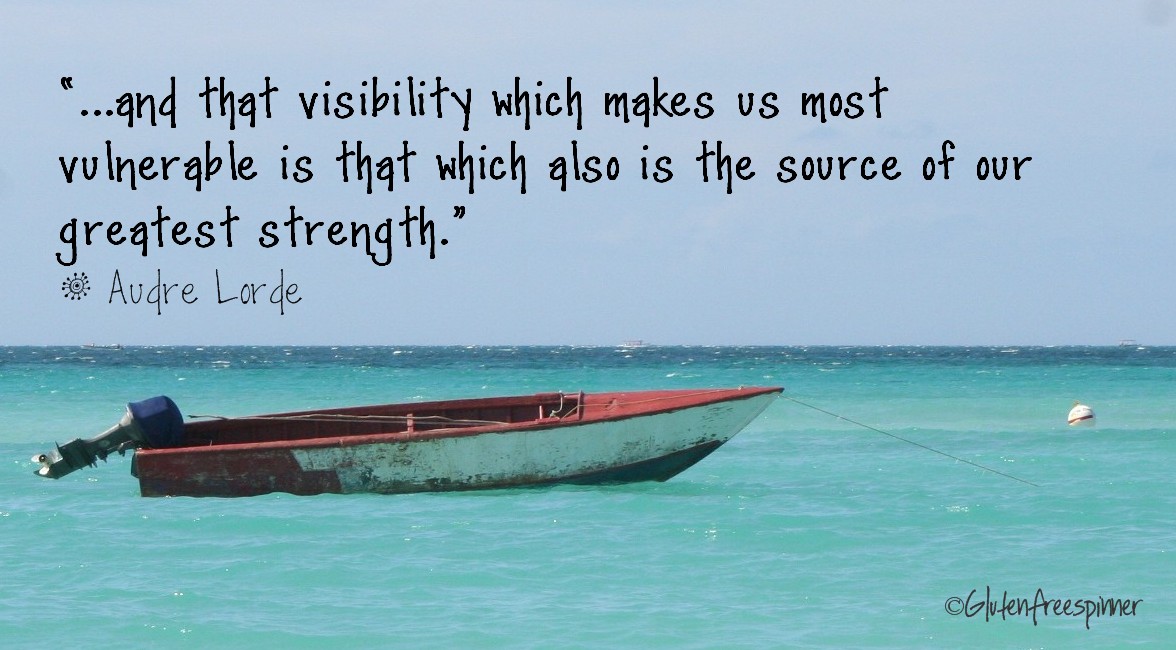What is vulnerability?
 Vulnerability has been an abiding challenge for me, and something I have reflected on a lot over the years in terms of what it means, how much of it I show, and the level of trust that vulnerability requires. Vulnerability is scary on the one hand, but can be freeing and powerful on the other. Brene Brown, a Social Researcher in the area of vulnerability and shame defines vulnerability as “uncertainty, risk and emotional exposure.” Think about the vulnerability it takes to love someone – whether it’s your parents, siblings, spouse or close friends. Love is filled with uncertainties and risks. The person you love might or might not love you back. They might be in your life for a long time or they might not. They might be terrifically loyal or they might stab you in the back. Think about the vulnerability it takes to share your ideas with the world, not knowing how your work will be perceived. You might be appreciated, laughed at or downright skewered. So perhaps we can already see why so many of us are at pains not to show it, even though as Freud says, “the truth bleeds”. I know in my own experience, even when I have created what I might consider to be a poker face (whilst dealing with the churn of anxiety internally) facilitating a difficult Team session, people have told me that it shows! During her early research, Brown found that people who felt worthiness about themselves:
Vulnerability has been an abiding challenge for me, and something I have reflected on a lot over the years in terms of what it means, how much of it I show, and the level of trust that vulnerability requires. Vulnerability is scary on the one hand, but can be freeing and powerful on the other. Brene Brown, a Social Researcher in the area of vulnerability and shame defines vulnerability as “uncertainty, risk and emotional exposure.” Think about the vulnerability it takes to love someone – whether it’s your parents, siblings, spouse or close friends. Love is filled with uncertainties and risks. The person you love might or might not love you back. They might be in your life for a long time or they might not. They might be terrifically loyal or they might stab you in the back. Think about the vulnerability it takes to share your ideas with the world, not knowing how your work will be perceived. You might be appreciated, laughed at or downright skewered. So perhaps we can already see why so many of us are at pains not to show it, even though as Freud says, “the truth bleeds”. I know in my own experience, even when I have created what I might consider to be a poker face (whilst dealing with the churn of anxiety internally) facilitating a difficult Team session, people have told me that it shows! During her early research, Brown found that people who felt worthiness about themselves:
- Have the courage to tell the story of who they really are complete with imperfections, with their “whole heart” (the original meaning of courage from the Latin word)
- Have innate compassion with themselves first, and then with others
- Have strong connectivity with others as a result of being authentic, not who they think they should be
- Fully embrace vulnerability, as what makes us vulnerable is also what makes us beautiful
 We can go out of our way to avoid being vulnerable through denial that there are problems, through approaches like perfectionism or “being stronger”, through addiction to substances or unhealthy behaviours, or creating moral certainties to hide behind. Part of the core issue around vulnerability is that we can’t selectively numb emotions; when we numb anxiety, fear, panic, disappointment, we also numb joy, gratitude and happiness.
We can go out of our way to avoid being vulnerable through denial that there are problems, through approaches like perfectionism or “being stronger”, through addiction to substances or unhealthy behaviours, or creating moral certainties to hide behind. Part of the core issue around vulnerability is that we can’t selectively numb emotions; when we numb anxiety, fear, panic, disappointment, we also numb joy, gratitude and happiness.
“When we were children, we used to think that when we were grown-up we would no longer be vulnerable. But to grow up is to accept vulnerability… To be alive is to be vulnerable.” Madeleine L’Engle
Myths around vulnerability
According to Brene Brown’s research, there are 3 key myths around vulnerability: Vulnerability is weakness. The funny thing about vulnerability is that we love when others are open and honest with us. But when it comes time for us to share, we sort of freak out. Suddenly, our vulnerability is a sign of weakness. Brown describes vulnerability as the core of all emotions. “To feel is to be vulnerable,” she says. So when we consider vulnerability to be a weakness, we consider feeling one’s emotions to be so, too. But being vulnerable connects us with others. It opens us up to love, joy, creativity and empathy. Plus, when we look at what makes up vulnerability, we quickly start to see the opposite of weak. In her book Brown shares the various responses she received after asking her research participants to finish this sentence: “Vulnerability is ________.” These were just some of the replies: starting my own business; calling a friend whose child just passed away; trying something new; getting pregnant after having three miscarriages; admitting I’m afraid; having faith. As Brown says, “Vulnerability sounds like truth and feels like courage.”
Some of us don’t experience vulnerability. Many people say that they simply “don’t do vulnerability.” But, actually, everyone does vulnerability. Life is vulnerable. Being vulnerable isn’t the choice we have to make. Rather, the choice is how we respond when the elements of vulnerability greet us: uncertainty, risk and emotional exposure.  Many of us respond by avoiding vulnerability. But when we do, we typically turn to behaviours that don’t align with who we want to be. For instance, one of the ways we shield ourselves from vulnerability is with what Brown calls “foreboding joy.” When things are going well in your life, have you felt a pang of horror that something bad will happen? For instance, you just got a promotion at work. You’re excited and happy. But then, bam, a wave of doubt, I’m going to do something to screw this up washes over you. Or it’s oh, no! What if the company goes bankrupt? That’s foreboding joy. Brown describes it as “the paradoxical dread that clamps down on momentary joyfulness.”
Many of us respond by avoiding vulnerability. But when we do, we typically turn to behaviours that don’t align with who we want to be. For instance, one of the ways we shield ourselves from vulnerability is with what Brown calls “foreboding joy.” When things are going well in your life, have you felt a pang of horror that something bad will happen? For instance, you just got a promotion at work. You’re excited and happy. But then, bam, a wave of doubt, I’m going to do something to screw this up washes over you. Or it’s oh, no! What if the company goes bankrupt? That’s foreboding joy. Brown describes it as “the paradoxical dread that clamps down on momentary joyfulness.”
Vulnerability means spilling your secrets Some of us automatically balk at vulnerability because we assume that being vulnerable means wearing our secrets on our sleeves. We assume that being vulnerable means spilling our hearts to strangers, and as Brown puts it, “letting it all hang out.” But vulnerability embraces boundaries and trust, she says. “Vulnerability is about sharing our feelings and our experiences with people who have earned the right to hear them.”Being vulnerable takes courage. But it’s worth it. It’s worth it to be ourselves, to connect to others. So, in a kind of way there is discernment in who we allow ourselves to be vulnerable with by instinct, and whether they will “allow” us to be like that.
Vulnerability at work
 Showing chinks in your armour doesn’t necessarily undercut you as an individual, but can enhance you, although I guess if you take a systems view of this, it might also be if the system allows vulnerability. From a leadership perspective, it’s about role modelling that life is an experiment and openly admitting and learning from your own shortcomings and mistakes which creates an environment that allows others to do the same. “Vulnerability is the absolute heartbeat of innovation and creativity,” says Brown. “There can be zero innovation without vulnerability.”Vulnerability is the combination of uncertainty, risk, and emotional exposure. “To be an entrepreneur is to be vulnerable every day. You don’t get to opt out of it” . “If you don’t believe that you ‘do’ vulnerability, vulnerability is doing you, and probably wreaking havoc in your life.” I think being vulnerable is part of our humanity, and that good leaders are willing to let others see them as they truly are. Allowing your team to see and appreciate the emotions you are experiencing as you choose to take on risk, or as you move past prior failures to a bold new vision, takes courage. I believe when a leader shows their humanity, their basic, human vulnerability, it creates a much tighter, more trusting team.
Showing chinks in your armour doesn’t necessarily undercut you as an individual, but can enhance you, although I guess if you take a systems view of this, it might also be if the system allows vulnerability. From a leadership perspective, it’s about role modelling that life is an experiment and openly admitting and learning from your own shortcomings and mistakes which creates an environment that allows others to do the same. “Vulnerability is the absolute heartbeat of innovation and creativity,” says Brown. “There can be zero innovation without vulnerability.”Vulnerability is the combination of uncertainty, risk, and emotional exposure. “To be an entrepreneur is to be vulnerable every day. You don’t get to opt out of it” . “If you don’t believe that you ‘do’ vulnerability, vulnerability is doing you, and probably wreaking havoc in your life.” I think being vulnerable is part of our humanity, and that good leaders are willing to let others see them as they truly are. Allowing your team to see and appreciate the emotions you are experiencing as you choose to take on risk, or as you move past prior failures to a bold new vision, takes courage. I believe when a leader shows their humanity, their basic, human vulnerability, it creates a much tighter, more trusting team.
My own experience
 My family background was one in which it was important to get on with life, and show our best side to the world; the family script was that people didn’t really want to know your vulnerabilities; they were areas to be occasionally dealt with in dark recesses and to provide a “varnish” to the outside world. It took a lot of life learning and a few major and minor life events to break through the well established “coping wall” and let myself feel the vulnerability, be able to show it to others, and allow it in others. I get periodic anxiety in my consultancy work with groups, or 1-1 coaching, or my blog articles where I show myself to the world. What will people think? Will they like the work? Will they hate it? But for me to stop doing the work would mean losing a pivotal part of myself. So I’ll continue to put my words, my ideas, myself, out into the world. And, without question, putting ourselves out there means there’s a far greater risk of feeling hurt. My only caveat is that I remain cautious about who I show it to; they need to be accepting of the power of vulnerability too, and be prepared to bring down the guard…
My family background was one in which it was important to get on with life, and show our best side to the world; the family script was that people didn’t really want to know your vulnerabilities; they were areas to be occasionally dealt with in dark recesses and to provide a “varnish” to the outside world. It took a lot of life learning and a few major and minor life events to break through the well established “coping wall” and let myself feel the vulnerability, be able to show it to others, and allow it in others. I get periodic anxiety in my consultancy work with groups, or 1-1 coaching, or my blog articles where I show myself to the world. What will people think? Will they like the work? Will they hate it? But for me to stop doing the work would mean losing a pivotal part of myself. So I’ll continue to put my words, my ideas, myself, out into the world. And, without question, putting ourselves out there means there’s a far greater risk of feeling hurt. My only caveat is that I remain cautious about who I show it to; they need to be accepting of the power of vulnerability too, and be prepared to bring down the guard…
How to show vulnerability
The type of vulnerability I am suggesting encompasses who you are and what you can do to cultivate a safe environment to earn trust, to build trust, to reinforce trust, and to demonstrate trust within your work and home environment. There are more obvious ways to go about building trust, such as:
- Honouring your word
- Following through with your commitments
- Being consistent with your approach to managing, coaching, and communicating
- Being respectful and supportive of the other person’s opinion, ideas and points of view
- Ensuring alignment of shared goals in every conversation
- Consistently being mindful of the law of reciprocity
- Setting or re-setting expectations when needed
While these are all healthy practices that build trust, they will only take you so far. To build a culture of trust and the type of trust that develops the type of loyalty that’s unshakable and deep is through vulnerability. Ultimately, it requires the person to be human.
- Vulnerability-driven trust allows people to more comfortably and confidently share their mistakes, failures, challenges, feelings, and concerns that are often kept bottled up inside for fear that expressing them will be misinterpreted as a sign of weakness.
- To let ourselves be really seen for all our warmth and generosity, as well as out anxieties
- To believe that we are enough as we are
- Surround ourselves with friends and people that allow us our vulnerability, and are prepared to show theirs
- Preparedness to have courageous conversations when it isn’t being practised with someone we work with, are related to, or know well
“Owning our story can be hard but not nearly as difficult as spending our lives running from it. Embracing our vulnerabilities is risky but not nearly as dangerous as giving up on love and belonging and joy—the experiences that make us the most vulnerable. Only when we are brave enough to explore the darkness will we discover the infinite power of our light.” Brené Brown
This You tube clip of Brene Brown describing her work in vulnerability is really worth a watch.